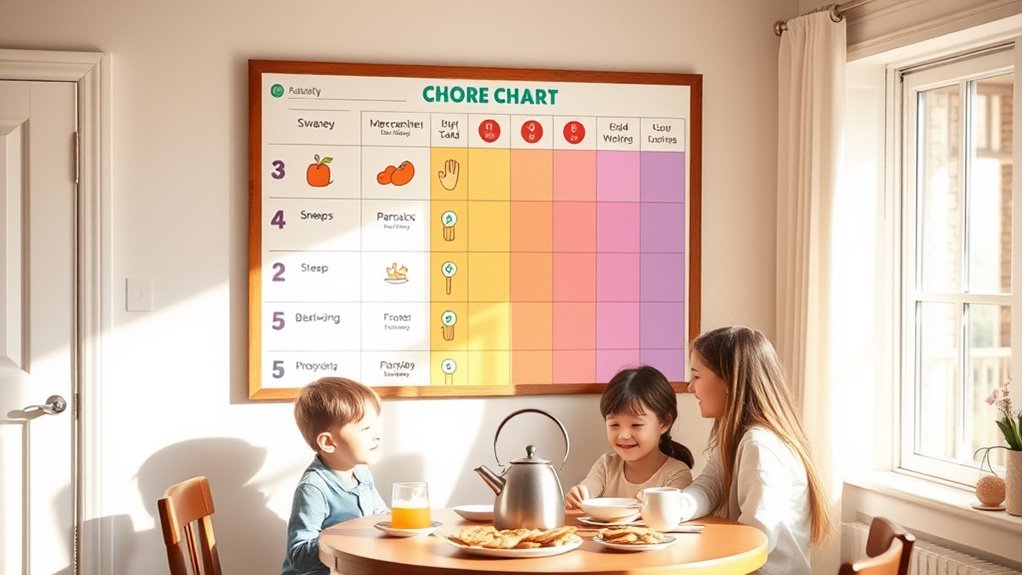Chore Schedules That Make Life Easier!
Chore schedules can truly transform your daily life! By breaking tasks into manageable segments, you’ll find chores feel less overwhelming. Assigning specific responsibilities to each family member not only promotes accountability but also boosts motivation when you see progress. Don’t hesitate to rotate tasks weekly; this keeps things fresh and helps everyone develop new skills. Incorporating family input in meetings can foster teamwork and guarantee everyone’s preferences are considered. And remember, customizing your system allows it to adapt as life changes. Stick around, and you’ll discover even more tips to make your chore schedule work for you!
Key Takeaways
- Establish a flexible chore schedule that accommodates family preferences and changing routines to reduce stress and increase productivity.
- Implement a chore chart to clearly outline responsibilities, promoting accountability and minimizing disputes among family members.
- Rotate tasks weekly to keep chores engaging and help family members develop new skills while preventing monotony.
- Conduct regular family meetings to discuss the chore system, ensuring everyone’s preferences are considered and fostering open communication.
- Use a reward system to motivate family members, recognizing their efforts and encouraging teamwork in completing household tasks.
Benefits of a Chore Schedule
Creating a chore schedule can really transform your home life for the better. It’s not just about keeping things clean; it’s about creating a structure that fosters improved productivity and reduced stress. When you have a clear plan in place, you’ll find that tasks become less overwhelming. Instead of feeling like you’re drowning in a sea of chores, you can tackle them one at a time, making your home more manageable.
By assigning specific chores for each day or week, you’ll also encourage accountability among family members. Everyone knows what’s expected of them, reducing the chance of disputes over who should do what.
Plus, with a chore schedule, you can track progress, which boosts motivation. Seeing those checkmarks adds a sense of accomplishment that’s hard to beat!
Don’t forget that a chore schedule can be flexible, adapting to your needs and routines. As you refine it, you’ll notice how much smoother your household runs.
Weekly Chore Rotation Ideas
When it comes to weekly chore rotation, assigning specific tasks to each family member can make a big difference.
You can also explore time block scheduling to guarantee everyone has a fair share of chores without feeling overwhelmed.
Let’s look at some practical ideas to keep things balanced and efficient!
Family Member Assignments
To keep your household running smoothly, assigning weekly chores can be a game changer. By implementing chore delegation, you not only streamline daily tasks but also foster family accountability.
Here are three effective strategies to rotate assignments among family members:
-
Create a Chore Chart****: Design a visual chart that outlines each family member’s responsibilities for the week. This clarity helps everyone know what’s expected and reduces confusion.
-
Rotate Tasks Weekly: Change assignments every week to prevent monotony. By rotating chores, you encourage family members to develop new skills and appreciate the effort that goes into each task.
-
Hold Weekly Check-Ins: Set aside time each week to discuss the completed chores. This not only reinforces accountability but also gives everyone a chance to share their thoughts and suggest improvements.
With these strategies, you’re setting the stage for a harmonious household.
Time Block Scheduling
Time block scheduling can really simplify your weekly chore rotation and make it feel more manageable. By using time blocking, you can allocate specific time slots for each chore, ensuring you stay focused and productive. This method helps you avoid the overwhelm that often comes with a long to-do list.
Start by identifying your weekly chores and breaking them down into manageable tasks. Then, assign time blocks for each task based on how long you think they’ll take. For example, you might set aside 30 minutes for vacuuming on Wednesdays and 45 minutes for laundry on Sundays.
To make this even more effective, consider pairing chores with your most productive times of the day. If you’re more energetic in the mornings, tackle the heavier tasks then.
Daily Task Management Tips
To make your day more manageable, it’s important to prioritize essential tasks that truly matter.
Try using time-blocking techniques to carve out dedicated slots for each activity, ensuring you stay focused and productive.
You’ve got this—small adjustments can lead to big improvements!
Prioritize Essential Daily Tasks
Prioritizing essential daily tasks is key to managing your time effectively and reducing stress. By focusing on what truly matters, you can create a sense of accomplishment and control over your day.
Start by identifying the tasks that will have the greatest impact on your goals, both in your morning routines and during your evening wind downs.
Here are three actionable steps to help you prioritize:
-
List Your Tasks: Write down everything you need to accomplish. This helps clear your mind and provides a visual cue of your responsibilities.
-
Evaluate Importance: Determine which tasks are urgent and which are important. Focus first on those that will propel you toward your long-term goals.
-
Set Time Limits: Allocate specific time slots for each task. This creates urgency and helps you stay on track.
Use Time-Blocking Techniques
One effective method for managing your daily tasks is by using time-blocking techniques. This approach helps you allocate specific chunks of time to various tasks, ensuring that you stay focused and productive.
The time blocking benefits are numerous; it not only minimizes distractions but also allows you to see exactly how your day is structured.
To start, identify the essential tasks you need to accomplish. Once you’ve got that list, assign time slots for each task throughout your day.
For effective time blocking, aim for intervals that suit your attention span—typically, 25 to 50 minutes of focused work followed by short breaks. This method reinforces accountability and helps you maintain momentum.
Involving the Whole Family
Getting the whole family involved in chore schedules can transform the way your household runs. By fostering family involvement, you not only share responsibilities but also create a sense of teamwork that can strengthen relationships.
Here are some practical communication strategies to get everyone on board:
-
Hold a Family Meeting*: Gather everyone to discuss the *chore schedule. Make it a fun, open forum where everyone can voice their preferences and ideas.
-
Assign Roles Based on Strengths: Identify each family member’s strengths or interests. Assign chores that align with these traits, making tasks feel less like obligations and more like opportunities to shine.
-
Create a Reward System****: Motivate family members by establishing a reward system. Whether it’s a family outing or a simple treat, recognizing effort can boost enthusiasm.
Customizing Your Chore System
Building on the excitement generated from involving the whole family, customizing your chore system can further enhance its effectiveness. Start by taking into account each family member’s personal preferences. Encourage them to express what tasks they enjoy or dislike. This helps foster a sense of ownership and guarantees everyone is more engaged in their responsibilities.
Next, implement task flexibility. Life can be unpredictable, so it’s important to allow some wiggle room in your chore assignments. For instance, if someone has a busy day, they should feel free to swap tasks with another family member. Establish a clear communication system for these adjustments to prevent confusion.
You might also consider rotating chores weekly. This not only keeps things fresh but allows everyone to develop new skills. Remember, mastery comes from practice, so the more they tackle different tasks, the better they’ll become.
Finally, regularly revisit your chore system together. Discuss what’s working and what isn’t, and be willing to adapt. This collaborative approach not only empowers your family but guarantees that the chore system remains effective and enjoyable for everyone.
Tools and Apps for Organization
While juggling family responsibilities can feel overwhelming at times, leveraging tools and apps for organization can make a significant difference in managing your chore system.
Embracing
Frequently Asked Questions
How Do I Handle Resistance From Family Members About Chores?
When handling resistance about chores, focus on communication strategies. Encourage open dialogue to understand concerns and promote conflict resolution. Collaborate on solutions that respect everyone’s needs, fostering a positive environment where everyone feels valued and heard.
What if Someone Forgets Their Assigned Chores?
Picture a blooming garden, vibrant yet needing care. If someone forgets their chores, consider reminder systems or accountability partners. These tools nurture responsibility, helping everyone flourish together in a harmonious space, encouraging growth and cooperation.
Can Chore Schedules Work for Kids of All Ages?
Absolutely, chore schedules can work for kids of all ages! By assigning age-appropriate tasks, you foster chore independence and help them develop responsibility. It’s rewarding to see them take pride in their accomplishments!
How Do I Adjust the Schedule for Unexpected Events?
Life’s unpredictable, right? So, embrace flexible scheduling! When unexpected events arise, adapt by creating contingency plans. It’s all about adjusting priorities and keeping your routine manageable, ensuring everything fits smoothly into your life. You’ve got this!
What Are Some Fun Ways to Reward Completed Chores?
To make chores enjoyable, consider using chore incentives like small treats or extra screen time. Establish reward systems that celebrate achievements, fostering motivation and a sense of accomplishment. You’ll find it’s a fun way to stay engaged!



